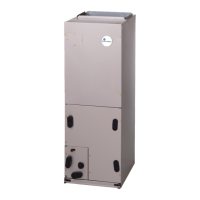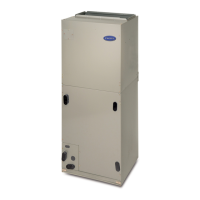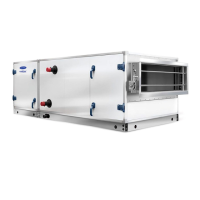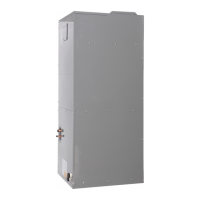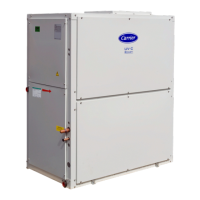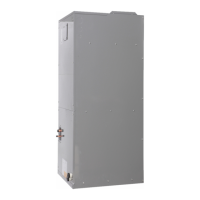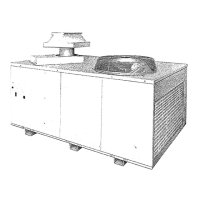77
In this test, each actuator/damper assembly is commanded inde-
pendently while the fan and motor characteristics are monitored.
It is possible to manually start the self-test:
• In Navigator, this test will be located at Service Test
FANS
E.TST.
• Running the test will require setting Service Test
TEST=ON.
The test will also automatically run based on EC.DY and EC.TM:
• If conditions are acceptable to run the self-test (see below),
the test will be automatically started on the configured day
EC.DY at the configured time EC.TM.
• If conditions are not acceptable to run the self-test, it will
be re-scheduled for 24 hours later.
The economizer self-test will only be allowed to run if all of the
following conditions are valid:
1. The economizer is enabled.
2. The second economizer actuator is enabled.
3. No actuators are detected as stuck.
4. No actuators are detected as unavailable.
5. RCB1 is properly communicating.
6. The unit is not down due to failure (A152).
7. The unit has a supply fan VFD and the fan is not in bypass
mode.
8. If configured for building pressure, the unit has an return
fan VFD and the fan is not in bypass mode.
In addition to the above conditions, the economizer self-test will
not be automatically run if the following condition is valid:
Unit not in OFF or VENT mode.
The Test screen should be similar to the following:
Setting EC.TS=ON will perform the following:
1. Command all actuators and dampers to the closed position.
2. Run the fan at T24SFSPD for T24ACMRT minutes and
take a baseline torque (VFD1TMAV) measurement. With
the dampers closed, there will be the least amount of air-
flow, and therefore the least amount of motor torque.
3. Modulate a single actuator/damper assembly open to
T24ACOPN. This will increase the airflow.
4. Let the motor run for one minute. If the torque has
increased by VF.PC% over the baseline measurement
from Step 2, the current torque is set as the new baseline
measurement and proceed to Step 5. If the torque has not
increased by VF.PC%, continue to run the fan for a total of
AC.MR minutes. If, after AC.MR minutes total, the torque
has not increased by VF.PC% over the Step 2 baseline
measurement, a fault is logged, and the test is ended.
5. Modulate the actuator/damper assembly closed.
6. Let the motor run for one minute. If the torque has decreased
by VF.PC% over the baseline measurement from Step 4, the
current torque is set as the new baseline measurement; pro-
ceed to Step 7. If the torque has not decreased by VF.PC%,
continue to run the fan for a total of AC.MR minutes. If, after
AC.MR
minutes total, the torque has not decreased by
VF.PC% below the Step 4 baseline measurement, a fault is
logged, and the test is ended.
7. Repeat Steps 1-5 for each additional actuator/damper
assembly.
8. Command actuators/dampers to “normal” positions.
If the torque increases and decreases properly, EC.ST="PASS,"
otherwise EC.ST="FAIL".
If EC.ST is set to pass, any existing “damper not modulating” alert
will be automatically cleared.
If EC.ST is set to fail, the “damper not modulating” alert will be
logged.
If at any point in the test the fan does not reach the command
speed or an actuator does not reach the command position within
five minutes, the test will be stopped and the status set to “NOT
RUN.”
FAULT DETECTION DIAGNOSTIC CONFIGURATION
POINTS
Log Title 24 Faults (LOG.F)
Defines when Title 24 mechanically disconnected actuator faults
should be logged. When set to YES, it will attempt to detect and
log mechanically disconnected actuator. When set to NO, it will
not attempt to detect and log mechanically disconnected actuator.
Default is NO.
T24 Econ Move Detect (EC.MD)
The amount of change required in economizer reported position
before economizer is detected as moving. The range is between 1
and 10. Default is 1.
T24 Econ Move SAT Test (EC.ST)
The minimum amount economizer must move in order to trigger
the test for a change in SAT; i.e., the economizer must move at
least T24ECSTS% before the control will attempt to determine
whether the actuator is mechanically disconnected. The range is
between 10 and 20. Default is 10.
T24 Econ Move SAT Change (S.CHG)
The minimum amount (in degrees F) SAT is expected to change
based on economizer position change of T24ECSTS with a range
of 0 to 5. Default is 0.2.
T24 Econ RAT-OAT Diff (E.SOD)
The minimum difference (in degrees F) between RAT (if avail-
able) or SAT (with economizer closed and fan on) and OAT to
perform mechanically disconnected actuator testing with a range
of 5 to 20. Default is 15.
T24 Heat/Cool End Delay (E.CHD)
The amount of time (in minutes) to wait after mechanical cooling
or heating has ended before testing for mechanically disconnected
actuator. This is to allow SAT to stabilize at conclusion of me-
chanical cooling or heating. The range is 0 to 60; default is 25.
SAT Settling Time (SAT.T)
SAT_SET/2 is the amount of time (in seconds) economizer report-
ed position must remain unchanged (±EC.MD) before the control
will attempt to detect a mechanically disconnected actuator. This
is to allow SAT to stabilize at the current economizer position.
This configuration sets the settling time of the supply-air tempera-
ture (SAT). This typically tells the control how long to wait after a
stage change before trusting the SAT reading, and has been reused
for Title 24 purposes. The range is 10 to 900; default is 240.
T24 Test Minimum Position (ET.MN)
Minimum position below which tests for a mechanically discon-
nected actuator will not be performed. For example, if the actuator
moves entirely within the range 0 to ET.MN, a determination of
whether the actuator is mechanically disconnected will not be
made. This is due to the fact that at the extreme ends of the actua-
tor movement, a change in position may not result in a detectable
change in temperature. When the actuator stops in the range 0 to
2% (the actuator is considered to be closed), a test will be per-
formed where SAT is expected to be approximately equal to RAT.
If SAT is not determined to be approximately equal to RAT, a
“damper not modulating” alert will be logged. Range is 0 to 50;
default is 15.
EC.TR ON
EC.DT WAITING
S.VFD 20.0%
TORQ 17.5%
ECN.P 20%
EC2.P 0%
EC3.P 0%
EC.ST RUNNING

